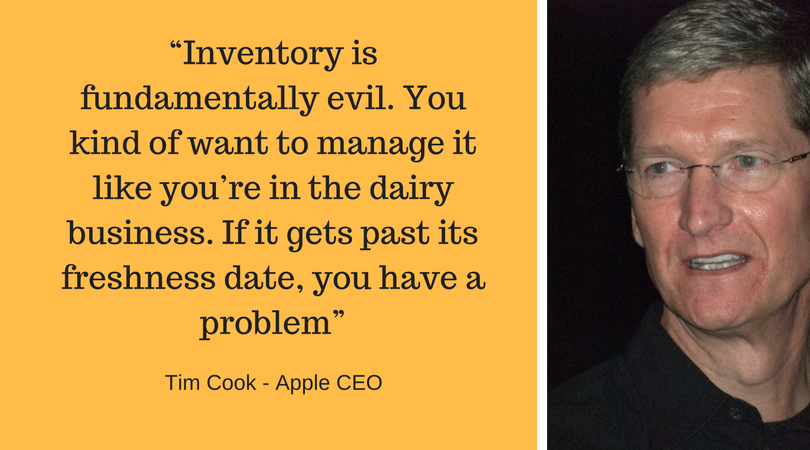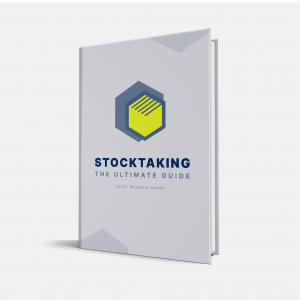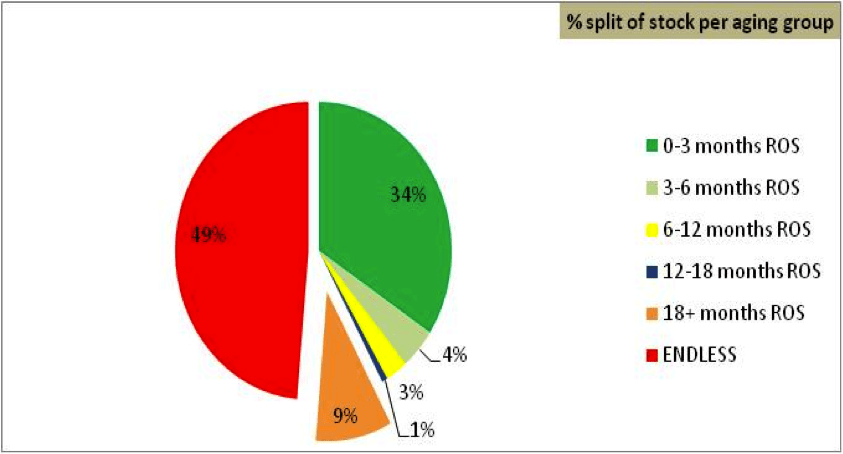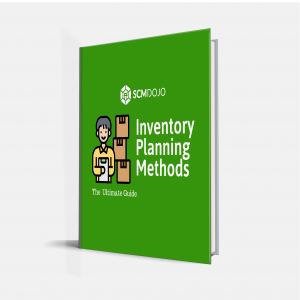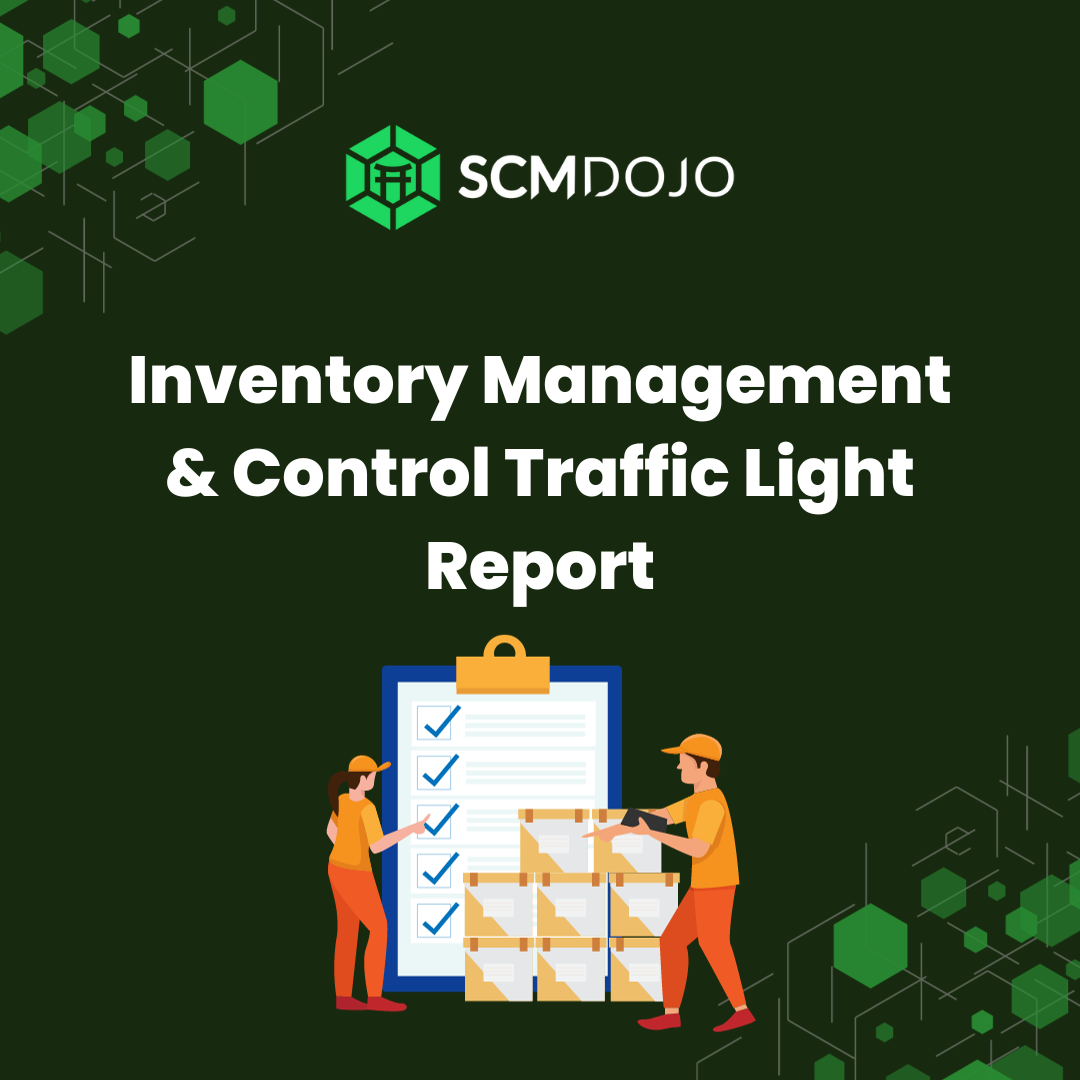Inventory comprises an important part of current assets, particularly in the manufacturing industry. A lot of cash flow is committed to inventories so as to ensure a smooth flow of production to meet a demanding customer service level. However, maintaining inventory also involves holding or carrying costs along with opportunity costs. Therefore, identifying inventory reduction strategies becomes critical for supply chain and operations professionals.
Efficient inventory management balances benefits and drawbacks, ensuring business success and survival. As Apple CEO Tim Cook says:
To help SCMDOJO Community we have developed an Inventory Optimization Tool in Excel that will do all all the optimization work for you in minutes & hours rather than days.
Inventory Optimization Tool in Excel
Here is a List of Inventory Reduction Strategies you can Try to Improve Inventory Turns
1. Reduce Total Supply Chain Lead Times
A reduction in total supply chain lead time will lead to products/materials not being held in stock for a long time. Reducing supplier lead time and manufacturing lead time will contribute to inventory reduction. To reduce lead time, the throughput, WIP, and cycle time will need to be measured to get a realistic estimation of a reduction in lead time. This, in turn, will reduce the risks related to holding inventory for longer periods.
The easiest way to understand total supply chain time is to perform high-level supply chain mapping. Starting from upstream of the supply chain and mapping out the average lead-time to downstream of the supply chain. I have found this exercise very useful to present visually to the team involved to show how much inventory we should be carrying at each stage of the supply chain.
2. Reduce Manufacturing Lead Time
Whilst I have seen a lot of focus in reducing the total supply chain lead-time and/or supplier lead-time, there is, however, not enough focus in reducing the internal manufacturing lead-time.
When considering the planning method, you should consider manufacturing lead-time in the total planning lead-time. For example, if you are using MRP and have 20 days of manufacturing lead time, it will take this 20 days into account to order raw materials for a given supplier lead time. Similarly, MRP will ask you to release the work order 20 days before it is supposed to be completed for sale or subsequent operation and will be driving 20 days’ Work in Progress (WIP) Inventory.
So, suppose you reduce this lead time of 20 days to 5 days in your MRP system. In that case, MRP will only ask you to release the work order 5 days before it is supposed to be completed for sale or subsequent operation, therefore reducing WIP inventory by 15 days!
If you don’t trust me, try it for a few items and you will see! However, I must admit this is one of the most difficult inventory reduction strategies to implement.
The best way to know what your actual manufacturing lead time is is to measure the time when the work order is released and when it is completed or if you have lean experts in the business performing the value stream mapping. And try to work with production folks to reduce this manufacturing lead time!
3. ABC Analysis to Identify MTS/MTO Changes
Using Pareto ABC analysis will help determine which inventory is used most often. In very simple terms, A is the inventory that is used the most, B- is products that are important but are used less frequently, and C these are products that are rarely used. “A” classification products are used frequently and can therefore be ordered in a small quantity, or be delivered Just in time and will require less safety stock, and C products can be ordered less frequently but with more safety stock kept. In my experience, this is the most effective and fast method of inventory reduction!
There are many benefits of ABC analysis (see below video), but for me the biggest benefits are to identify your Made to Stock (MTS), Assemble to Order (ATO) and Made to Order (MTO) items. Since A items are your runners and repeaters, they should be MTS items with adequate safety stock.
B items can be treated as ATO by only carrying raw materials in stock and C items should MTO. This is a must-have initiative for any business who is devising inventory reduction ideas.
4. Improve Supplier Rapport
Having an improved relationship with suppliers is highly beneficial not only to the whole supply chain but also to inventory reduction. Having a rapport with the supplier will mean effective communication between the parties. The suppliers have the best knowledge of the products they produce, and this can be utilised with a good rapport as this information can be shared. By having a good relationship with the suppliers, communicating will be easier.
5. Smaller Order Sizes
Ordering a smaller volume of inventory, more frequently is beneficial for the company to manage cash flow and also inventory reduction. Depending on the product, this will reduce costs associated with keeping a higher volume of inventory. As a result, the inventory on hand will be low, but the replenishment frequency will be higher. Having less inventory reduces several risks associated with keeping inventory e.g. issues that can cause a product to depreciate in value.
6. Reduce Obsolete Stock
By identifying, repurposing or removing obsolete inventory the volume of inventory on hand will decrease. With this, both direct and indirect costs of keeping the obsolete inventory will be reduced. This closely links to reducing order sizes as a smaller volume of the inventory will be in stock, and as a result, fewer inventories will be in stock and become obsolete.
The obsolete stock is generally hidden in many different places in the warehouse. Therefore, no one knows the extent of space being wasted. Before and during stocktake (physical inventory) I ask warehouse folks to consolidate in one area, so we know how many pallet spaces being wasted, which could be utlized efficiently if we don’t have those piles of Obsolete stock!
Stocktaking: The Ultimate Guide (Stocktaking Procedure)
We have published an extensive blog on Excess and Obsolete Inventory Is Killing Your Business – 9 Ways You Can Survive .
Morever, you can download Excess and Obsolete Policy guidelines for adjustments, disposition, inventory valuation, and reserves.
7. Conduct Regular Safety Stock Review
Once Made to Made-to-Stock (MTS) items have been identified post-ABC Analysis, planners should review the safety stock every 6 months (may be every 3 months in some cases) as a minimum as one of the most essential inventory reduction strategies.
As we know, the safety stock in employed to absorb lead-time variation and demand variation of customer demand and achieve required service level (95% in in most cases). Maintain and review right safety stock is paramount to achieve the right customer service levels and market lead times, hence it is an action of strategic importance.
There are many formulas available to calculate safety stock; you can pick one, which is suitable to your business. Make sure you understand it is difficult to analyze safety stock for the New Product Introduction, but at this time, you have to agree on the launch quantity.
Please also note that the review of safety stock goes hand in hand with ABC analysis for your business. Once safety stock is changed, you should be able to forecast the increase or decrease in stock based on forward demand/forecast and track the “planned” vs. “actual” impact to include in the inventory reduction plan.
If you lack the resources to conduct regular safety stock reviews, then hire a freelancer Inventory analysis. I know a few good and reliable inventory analysts who can do this twice per annum at very low rate if you don’t have internal resource and expertise. This could be useful, as you don’t have to have expertise in-house to get this analysis done. Contact me if you need one!
Like ABC analysis this exercise again is one of the key activities out of all inventory reduction ideas in scope.
Get Excess and Obsolete Inventory Policy
8. Check Aging and Reach of Stock (ROS) for your inventory
One way to find out what inventory to target is to understand what items you are carrying are more than 12 months old, meaning they are not turning faster and need special focus actions to reduce them.
Reach of stock is a simple analysis which identifies how many days certain stock inventory will last based on historical demand.
For example, in the graph below, 34% of SKU only have stock to cover 0-3 demand or ROS, similarly, 49% of items are obsolete items with no demand, hence, Endless ROS and priority items to focus on inventory reduction strategy.
9. Measure Each Planner/Buyer Individually with Clear Ownership.
It is not uncommon that inventory as balance sheet items is driven by finance. However, I argue this point strongly and promote with all my colleagues that inventory is owned by the supply chain; therefore, the supply chain team(s) should drive inventory action and ensure realistic targets are set.
Generally, inventory is assigned to a plant and owned by a Supply Chain team with support from finance. Therefore, it is more that each planner and buyer should have their own individual targets for the production cells they are planning or buyer for raw materials inventory from 1st or 2nd tier supplier.
If you are a manager of people, then you have to make sure that clear inventory ownership, targets, and commitments are in place, and managerial focus is provided to drive inventory reduction actions.
10. Conduct Inventory Self Audit or Assessment
When inventory is out of control, conducting the Inventory Self Audit or Assessment is worthwhile. In addition to inquire about the implementation of above strategies, you can ask the following question as an example to understand why inventory is out of control:
- The business analyzes their inventory at a granular level to identify right-sizing opportunities.
- The business has a stated service level strategy and has established inventory targets by category.
- Are WIP levels monitored within each manufacturing process or by local supervision, which then own this value as one of the metrics they have to react to?
I am aiming to develop a self-audit tool so the supply chain professionals can answer the questions as Yes or No format and understand where they stand.
I have written a very ultimate guide of the stocking, which is a result of 13 years of experience in planning, executing and analyzing annual stocktakes. This guide is 40 pages long with a word count of 6752.
I have made this guide available in both PDF and Microsoft Word documents, so you can chop, change and adapt to your business! for readers of this blog you can utilize 30% discount using code: stocktake1
11. Pull Based Demand / Replenish Based on Demand
A way for inventory reduction is by having a pull based demand system or JIT System. This means to only manufacture the product once it has been made, therefore reducing the risk of obsolete stock as all the materials ordered are being used to make the product. This is different from making a product then selling it therefore as the demand is not certain, this will make forecasting easier. Therefore, it reduces inventory as it is only ordered when it is needed (this needs a good supplier rapport and short lead time).
12. More Accurate Forecasting
Having a standardized reliable way of forecasting demand will mean that excess stock is not ordered and will reduce the chance of obsolete stock. Utilising all the data available and using up-to-date technology can help with reductions. Having a more streamlined supply chain with information being passed along and shared can also increase the chance of a better forecast, as more information is available.
13. Reduce SKU or Delayed Differentiation
Reducing the number of SKU’s in a range will mean less of the differentiated products will be produced and allow the benefits of manufacturing homogenous products.
However, this reduction can be difficult, but a way of reducing the costs that are associated with the differentiation e.g., a machine is reconfigured with a new set of algorithms in order to facilitate for the new product, this will save time but another way to diminish the cost would be by delaying the differentiation process to as far down the line as possible so as to not cause a disruption to the other products in production.
I must admit, to implement this mostly depends on the marketing and engineering departments, therefore, one of the more difficult inventory reduction strategies.
14. Better Measuring System
Implementing a system that will recognise when a product needs replenishing and is dynamic can also be useful. Using a system that can change how much to order not only by using how much current stock is on hand but by also a change in trends will help reduce the chance of obsolete stock and excess stock.
15. More versatile components
Using a material or component that is versatile will result in inventory reduction. Ordering a material that can be used in many different products can reduce the inventory on hand. This is because the one material can go into several products. If the material has a high inventory turnover then it can be ordered in a smaller quantity often as above.
16. Highest Spend Supplier should be on VMI or Consigned Inventory Programs
Move inventory upstream in supply chain by using Vendor Managed Inventory (VMI) or Consigned Inventory Program. With Strategic suppliers who supply high value, volume and frequency items can keep a minimum and maximum stocks for you as long as you can cover the liability of that inventory. That means you can simply cut the manufacturing lead-time and pull from stock, in turn reduce your safety stocks and/or cycle stocks. Again, I have used this technique quite a lot in my 10 year supply chain career and consider this as one of the most highly impactful inventory reduction strategies.
17. Focus on Top 50 high value inventory Items
During my 10 years in supply chain planning, I have found between 20%-25% inventory sits with Top 50 high value inventory items (may vary with different business!). I always ask my material planners to focus on those and “micromanage” them and for rest they can use MRP and Parameter setting. And by applying one or more of the other 17 inventory reduction Ideas mentioned in this blog, you can reduce significant amount of inventory related to these Top 50 high value inventory items and free up some cash flow.
18. Drive Standard Cost Reduction to Lower Gross Inventory Value
In most business reduce cost of piece price is an immense focus to increase profitability. This drive of cost reduction mostly ends up in reduction of piece or unit price. Which in turn has a positive impact in the inventory valuation.
If you work in business where standard cost only changes once per year, you have to ensure that the financial controls are on your side to reflect the cost reduction in piece price! I would go as far as saying partnership with financial controllers is a must-have for implementing inventory reduction strategies.
Final Thoughts:
A consistent use of these inventory strategy over the next few months will help your business to remain competitive and decrease inventory, while reducing operating costs and improving customer service.
Furthermore, the inventory management strategies will augment business operations by the effective and efficient flow of goods and services. It adds to profitability, competitiveness, service optimization and market diversification.
If you like this article or have any other inventory reduction strategies to add please add in comments below.
Recommended Reading
Essentials of Inventory Management
Inventory Accuracy: People, Processes, & Technology
The Definitive Guide to Inventory Management: Principles and Strategies for the Efficient Flow of Inventory across the Supply Chain (Council of Supply Chain Management Professionals)
About the Author- Dr Muddassir Ahmed
Dr MuddassirAhmed is the Founder & CEO of SCMDOJO. He is a global speaker, vlogger and supply chain industry expert with 17 years of experience in the Manufacturing Industry in the UK, Europe, the Middle East and South East Asia in various Supply Chain leadership roles. Dr. Muddassir has received a PhD in Management Science from Lancaster University Management School. Muddassir is a Six Sigma black belt and founded the leading supply chain platform SCMDOJO to enable supply chain professionals and teams to thrive by providing best-in-class knowledge content, tools and access to experts.
You can follow him on LinkedIn, Facebook, Twitter or Instagram


